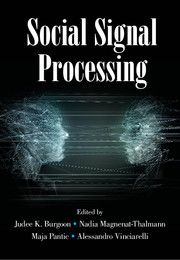Book contents
- Frontmatter
- Contents
- Contributors
- 1 Introduction: Social Signal Processing
- Part I Conceptual Models of Social Signals
- Part II Machine Analysis of Social Signals
- Part III Machine Synthesis of Social Signals
- Part IV Applications of Social Signal Processing
- 24 Social Signal Processing for Surveillance
- 25 Analysis of Small Groups
- 26 Multimedia Implicit Tagging
- 27 Social Signal Processing for Conflict Analysis and Measurement
- 28 Social Signal Processing and Socially Assistive Robotics in Developmental Disorders
- References
25 - Analysis of Small Groups
from Part IV - Applications of Social Signal Processing
Published online by Cambridge University Press: 13 July 2017
- Frontmatter
- Contents
- Contributors
- 1 Introduction: Social Signal Processing
- Part I Conceptual Models of Social Signals
- Part II Machine Analysis of Social Signals
- Part III Machine Synthesis of Social Signals
- Part IV Applications of Social Signal Processing
- 24 Social Signal Processing for Surveillance
- 25 Analysis of Small Groups
- 26 Multimedia Implicit Tagging
- 27 Social Signal Processing for Conflict Analysis and Measurement
- 28 Social Signal Processing and Socially Assistive Robotics in Developmental Disorders
- References
Summary
Introduction
Teams are key components of organizations and, although complexity and scale are typical features of large institutions worldwide, much of the work is still implemented by small groups. The small-group meeting, where people discuss around the table, is pervasive and quintessential of collaborative work. For many years now, this setting has been studied in computing with the goal of developing methods that automatically analyze the interaction using both the spoken words and the nonverbal channels as information sources. The current literature offers the possibility of inferring key aspects of the interaction, ranging from personal traits to hierarchies and other relational constructs, which in turn can be used for a number of applications. Overall, this domain is rapidly evolving and studied in multiple subdisciplines in computing and engineering as well as the cognitive sciences.
We present a concise review of recent literature on computational analysis of face-toface small-group interaction. Our goal is to provide the reader with a quick pointer to work on analysis of conversational dynamics, verticality in groups, personality of group members, and characterization of groups as a whole, with a focus on nonverbal behavior as information source. The value of the nonverbal channel (including voice, face, and body) to infer high-level information about individuals has been documented at length in psychology and communication (Knapp & Hall, 2009) and is one of the main themes of this volume.
In the chapter, we include pointers to 100 publications appearing in a variety of venues between 2009 and 2013 (discussions about earlier work can be found e.g. in Gatica-Perez, 2009.) After a description of our Methodology (see section on Methodology) and a basic quantitative analysis of this body of literature (see section on the Analysis of Main Trends), we select a few works, due to the limited space, in each of the four aforementioned trends to illustrate the kind of research questions, computational approaches, and current performance available in the literature (see sections on Conversational Dynamics, Verticality, Personality, and Group Characterization). Taken together, the existing research on small-group analysis is diverse in terms of goals and studied scenarios, relies on state-of-the-art techniques for behavioral feature extraction to characterize group members from audio, visual, and other sensor sources, and is still largely using standard machine learning techniques as tools for computational inference of interaction-related variables of interest.
- Type
- Chapter
- Information
- Social Signal Processing , pp. 349 - 367Publisher: Cambridge University PressPrint publication year: 2017
References
- 9
- Cited by



